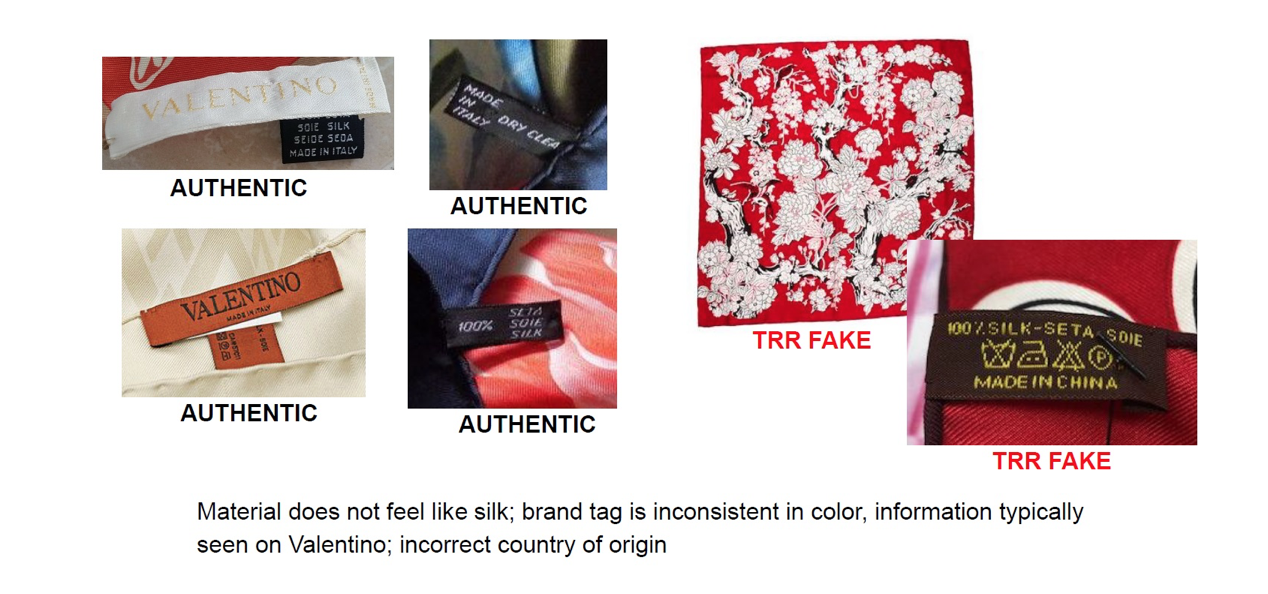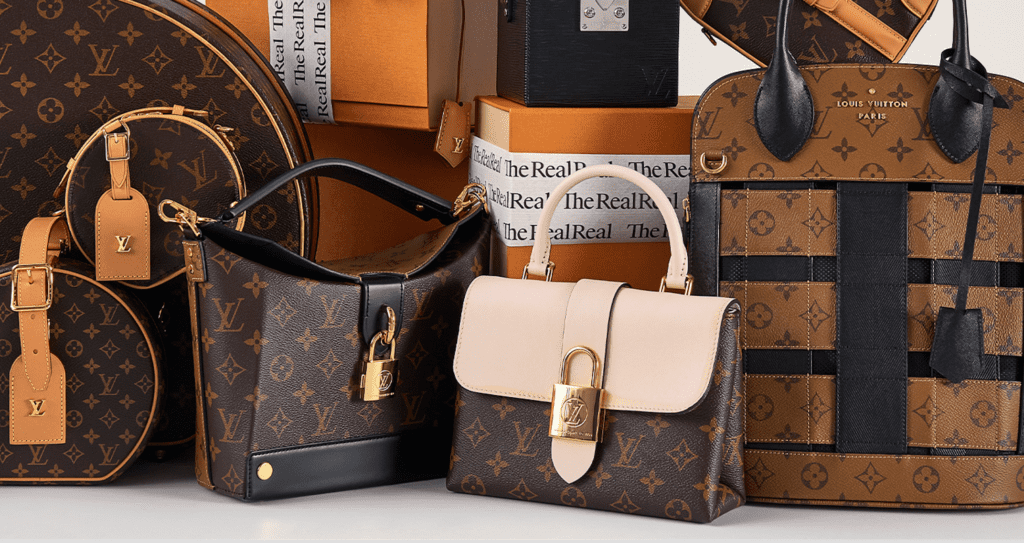CNBC has doubled-down on its investigation of The RealReal, issuing a second report in almost as many weeks detailing “how deep” the luxury resale platform’s alleged “authentication problems have been for some time.” Pointing to more than 200 pages of internal documents, CNBC says that on the heels of initially reporting about the “questionable” methods the resale titan uses to ensure the authenticity of the products it sells, the news outlet got its hands on “weekly recaps” that it says detail the “counterfeit products that had slipped through the cracks of the [The RealReal’s] vetting process” and were sold, and subsequently returned.
Called “Copywriting Faux and Tell,” the internal documents “were sent to copywriters at the company’s warehouse in Brisbane, California” during the first and third fiscal quarters of 2019, according to CNBC, and include “purported Louis Vuitton slides in a style that was never created, Ugg boots marked with [a counterfeit] logo and [improperly-placed] bow, sandals from ‘The Row,’ and a Valentino scarf that [would have been] made in Italy [if authentic],” but that came with an “inconsistently” colored label that said ‘Made in China.’”
Included in another one of the company’s weekly recaps was an obvious pair of “fake Jimmy Choo shoes,” which “misspelled the brand name as ‘Jimmy Ghoo’ on the sole,” and were packaged in a yellow box. The RealReal report noted that “Jimmy Choo has never used a yellow box.” Other unnamed products, including designer handbags, were found to have “inferior screws,” “incorrect hardware,” “incorrect fonts on labels,” “sloppy interior stitching,” and/or a “strong chemical odors,” according to The RealReal’s weekly materials.
The 8-year old The RealReal told CNBC that it does “not share specific details on our proprietary training programs,” but did reveal to TFL that there is, in fact, more to this story.
Speaking specifically to the “Copywriting Faux and Tell” documentation, a representative for the San Francisco-based startup told TFL on Thursday that it engages in “ongoing daily and weekly training sessions, [which] are a key component in our effort to stay one step ahead of counterfeiters.” While the company does “use counterfeit products from a variety of sources, including those identified during our authentication process, in our training sessions,” the products included in the “Copywriting Faux and Tell” docs “are not, as CNBC inaccurately stated, just from returns.”
One of the first movers in the online resale space, The RealReal has been able to build a more than $2 billion business by giving consumers access to pre-owned luxury goods that in years past would have been relegated to dusty consignment shops or the luxury aura-less expanse of sites like eBay. With fast-growing companies like The RealReal paving the way and younger consumers demonstrating their desire for pre-owned fashions, the market for pre-owned luxury goods has been radically disrupted.
The key to building a business that depends on consumers splashing out hundreds – and in many cases, even thousands – of dollars on pre-owned luxury goods online is trust, and consumers have shown a willingness to trust The RealReal, in some cases, enough to not only buy from the site but to bet on its success: with its June 2019 initial public offering, The RealReal garnered a market capitalization of $2.39 billion, with first day stock prices hitting a high of $30.05, well above the expected range of $17 to $19.
 image via CNBC
image via CNBC
Since then, the San Francisco-based company has boasted growing sales to eager consumers, a large pool of consignors, and gross merchandise sales that are expected to top $1 billion for 2019.
But its rise has not been without issues. As the volume of the company’s products – the majority of which come from consigning consumers – has grown significantly since it first started as a kitchen table operation of founder Julie Wainwright, so have questions about authenticity. These questions – or in some cases, qualms – have not been made easier to navigate by the fact that as companies like The RealReal continue to find favor amongst mainstream consumers, the $1.2 trillion market for counterfeit goods is also growing both in scale and sophistication.
For instance, China, the point of origin for the vast majority of the world’s counterfeits, has drastically improved its production capabilities since it first became a popular locale in the 1970s for mass-market Western companies to outsource their apparel and accessories manufacturing. Following decades of skill- and infrastructure-building, many higher-end (and even high fashion) brands have taken to enlisting Chinese entities for their manufacturing; the same level of skill required to make Balenciaga’s Triple-S sneakers – which are, in fact, made in China – can be used to manufacture counterfeit versions, as well. The result comes in the form of counterfeit products that are, at times, nearly unidentifiable to even the trained eye.
To add insult to injury, efficiency in terms of the distribution of fakes is also changing. In recent years, a growing number of professional counterfeit manufacturers and sellers are swapping traditional, large-scale methods of transportation, such as shipping products en masse via container ship, in favor of smaller – less obvious – methods. To be exact, they are looking to the mail and express couriers, such as UPS, FedEx, and DHL to send smaller qualities of goods as a way to evade detection by Customs agents. To a large extent, this is proving an effective tactic, and enabling large volumes of high-quality counterfeits to enter into the U.S., in particular, undetected.
Taken together, the overall influx of pre-owned products to sites like The RealReal (partially as a result of the sped-up fashion cycle) and a growingly sophisticated market of largely-Chinese-made fakes puts resale sites in a difficult position across the board. This seemingly unenviable position is exacerbated by the fact that as the Wall Street Journal’s Suzanne Kapner wrote this summer, while the brands, themselves, “are best-positioned to ferret out copycats, so far they are unwilling to work with sellers of preowned goods,” on the basis that “a booming secondary market will depress prices of first-run goods.”
It is against this background that The RealReal – whose CEO said in a message to the platform’s customers this month that it is “doing more to remove fakes than any other resale company” – has prided itself on its ability to sell authentic pre-owned luxury goods and to ensure that the questionable products it receives from consignors never make it to market.
CNBC’s most recent report comes on the heels of a tour de force of assurances from The RealReal that it “has the most rigorous authentication process in the marketplace” and that it is “the only resale company in the world that authenticates every single item we sell.” In furtherance of its dedication to “removing fakes from the market every day,” the RealReal’s November 21 release stated that in October, alone, the company “received nearly 490,000 products for consignment on our platform.” 4,000 of those products never made it into the site due to “concerns uncovered during authentication,” it said, while an additional 139 of those items “were rejected by our Quality Control team before being posted on our site.”
The company – which sits at the center of the luxury resale market, one that is expected to reach $36 billion in value by 2021 – does not release figures about the number of products that it sells that are ultimately returned due to authenticity issues. And according to CNBC, “Publicly available financial reports also do not break down the number of fakes” that the company has sold. However, what the burgeoning resale company does make very clear is that it stands behind its “business and our state-of-the-art authentication process,” as well as its “guarantee” that “if our customers aren’t happy or if they ever question one of our products, we always make it right.”
The question remains as to whether The RealReal’s “rigorous” approach to authentication – including the introduction of various uses of AI – and its steadfast guarantee for consumers is enough to withstand the increasingly large volumes of products it generates from consignors paired with the ever-growing level of sophistication of counterfeit goods. According to its latest revenue report, it does not appear to be suffering from a mass exodus of consumers-who-lost-faith: the number of active buyers using the consignment platform grew to 543,000 for the three months ending September 30; that figure is up from 492,000 for the previous quarter.
The far bigger question here (in my mind at least) does not center on The RealReal, in particular, but instead on whether a tagline like “100% real” – and more generally speaking, the premise behind it, which is the basis for how other resale sites operate, as well – is really a viable proposition in a situation where the wild west of counterfeits meets the wild west of e-commerce sales based on consumer-provided products. And if it isn’t (which very well might be the case, at least until there is better technology and/or brand participation), what does that mean for luxury resale as an industry?








